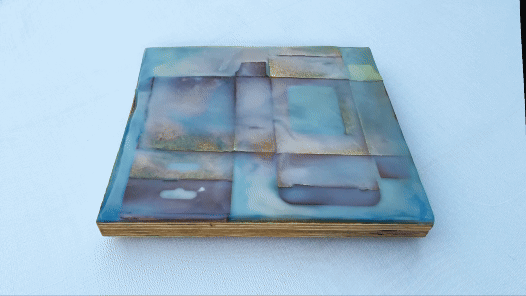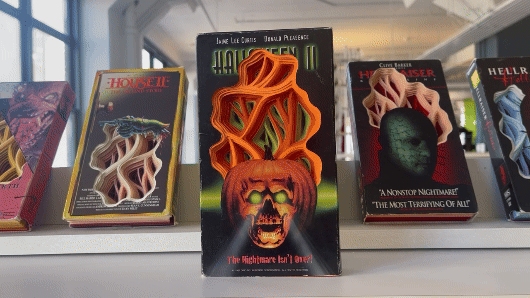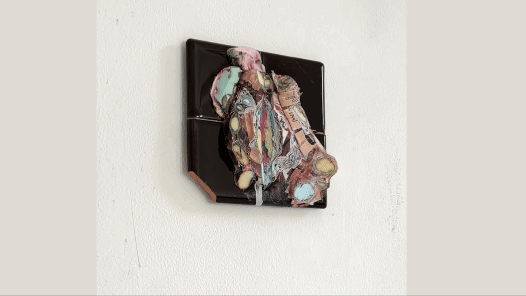In this digital based exhibition we ask you to slow down and look, to fight against our collective habit to swipe and scroll.
Coordinates: 40°42’54″N 73°59’15″W
USB Power Adapter 06, 2024, 8″ x 7″ encaustic collage on panel
view
Coordinates: 40.723681, -74.006436
Halloween II, 2015-ongoing, Hand Cut Paper and Found VHS Box, 7.5 x 4.5 in
view
Coordinates: 40°42’54″N 73°59’15″W
USB Power Adapter 06, 2024, 8″ x 7″ encaustic collage on panel
view
Thinkfiner is pleased to present digital twin : Consumer Layers, featuring the works of Joanne Ungar, Hedwig Brouckaert and Charles Clary. Artists in this exhibition utilize three-dimensional layering techniques, transforming paper into newly contextualized artworks. The artists in this exhibition explore consumerism, incorporating the marketing and packaging material into their artistic process.
Works included in ” digital twin : Consumer Layers” invite study of depth and details in layered work. For this exhibition and presentation, the three artists have documented their work and interactions with the surroundings, visually capturing and examining abstract concepts of place, emotion, and interconnectedness. Texture, color scheme, and form react and correspond with the elements of the site, offering a fresh significance through their interplay.
Artist Hedwig Brouckaert layered-paper collage on commercial tiles is constructed from cut-out imagery of models’ skin from mainstream magazines and layered over and over with glue and acrylic paint to create a bas relief. The artist then sands, cuts, and carves to reveal the deeper layers of paper and the shiny tiles beneath, uncovering strange patterns by breaking open the surface.
Contrasting the tightly layered and fused paper strata of Brouckaet’s artwork, Charles Clary creates a three-dimensional terrain with a spatial depth between each paper layer. His cut outs resemble land topographies inserted into a VHS box, which has a surreal depth and dimension created from hand-cut paper and stacking techniques.
While Charles Clary works have an open air between the layers, Joanne Ungar’s encaustic wax works both conceal and amplify the embedded cardboard packaging in cast layers of wax. Underpinning this work is Ungar’s interest in consumerism and its accompanying waste, packaging. Packaging is not only the refuse of consumerism, but the wrapping of it, too. packaging that has inherent negative spaces resulting from the die-cutting process; hand-made relief collages, offering a variety of surfaces, materials, and images; and relief carvings of the wood substrate.
All three artists repurpose paper materials from our consumerist world, and though the use of layering transform these modest materials into elevated works of art. The works on view are presented to capture their unique materiality, and the refraction, absorption, and transition of light on the artworks. Condensing time and capturing the transition of light throughout the day and the reactive quality to the artworks, ” digital twin : Consumer Layers” presents the works in a new context. We ask you to slow down and look, to fight against our collective habit to swipe and scroll.
Joanne Ungar artist statement
My current work utilizes recycled cardboard, sandwiched within layers of pigmented encaustic. Underpinning this work is my interest in consumerism and its accompanying waste and packaging. Packaging is not only the refuse of consumerism, but the wrapping of it, too. Its physicality is malleable, yet always recognizable, offering many modes of presentation. And like one of my earlier obsessions, bubble wrap, it contains an inherent tension between the organic and the geometric as it begins to break down after being subjected to various processes, with wisps or hints of corrugation often the last recognizable clue to what I’ve done. On a less concrete level, the double entendre of “packaging” allows me to re-present, (or re-package) these scraps, creating mementos and embalming them to function as time-capsule-like objects, possible future reminders of how casually careless we were with our only earth. The imagery the finished pieces imply is elusive and subjective, but often they evoke dystopian landscapes or ill-defined blueprints of submerged abstract structures. Many things mechanical and/or scientific are suggested, but too elusive to grasp, a metaphor for our current societal argument with factual/scientific knowledge.
Charles Clary artist statement
Charles Clary always felt a kindred spirit to the final person standing in a scary movie – surviving through the trauma. As a hand-cut paper artist Clary uses paper to create a world of fiction that challenges the viewer to suspend disbelief and venture into fabricated reality. Clary sources VHS tape copies of his favorite movies at his local thrift stores. Analog and carelessly discarded, these films held a lot of emotional significance to Clary, who saw them as “beautiful scarifications,” a traumatic moment healed by a film. In his work Clary designs around what he feels is important and then carefully cuts and layers paper into the slipcase of a VHS tape. Clary rescues these once-beloved items, transforming these objects into meticulously crafted objects that challenge viewers to reconsider the fleeting value consumer society places on once-cherished items.
Hedwig Brouckaert artist statement
‘Peel’ is my recent series of layered-paper collage on commercial tiles. I cut out imagery of models’ skin from mainstream magazines and layer it over and over with glue and acrylic paint to create a bas relief. I then sand, cut, and carve with sharp knives to reveal the deeper layers of paper and the shiny tiles beneath, uncovering strange patterns by breaking open the surface. I work with ceramic tiles for several reasons. They are part of my family’s history: my sister Elfriede was a mosaic artist, and my father collected a wide variety of tiles for her to work with. As a homage to them, I work with the collection of tiles they left behind after they both passed in 2015. Ceramic and marble tiles are also omnipresent as the architectural skin of public corridors and subway tunnels in New York City. On the old tunneled underground walls, over time complex images emerged by dirt and grime. They are repulsive and quite beautiful at once, suggestive of time passing and the complex layered society that is New York City. The title ‘Peel’ references my process of peeling away the surface in order to reveal what is underneath. In broader terms, to expose what is hidden includes openly acknowledging society’s injustices, examining our belief systems and biases, and as an individual peeling away the ego and the culturally conditioned mind. As in a memento mori, I reflect through my work on mortality and the vanity of life presented in the hyper-consumer world of today.
Digital Twin is a digital based project aimed at presenting a fresh perspective. It is artwork captured digitally in an original location, showcasing the interplay of light on surfaces, that alters the way art is experienced and opening the viewer up to novel ways of seeing. In this digital environment we ask the viewer to slow down and look, to fight against our collective habit to swipe and scroll.
Slow down. Focus. View each work.



